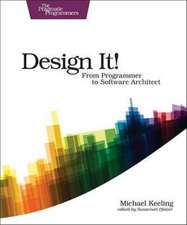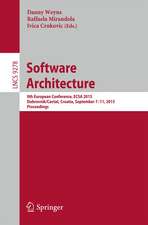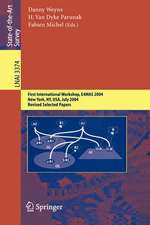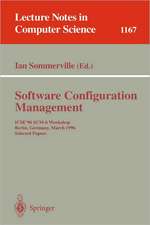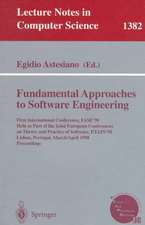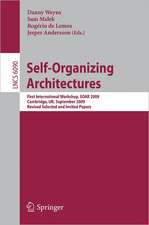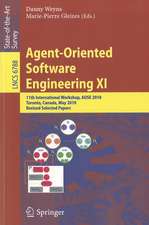Architecture-Based Design of Multi-Agent Systems
Autor Danny Weynsen Limba Engleză Paperback – 23 sep 2014
Danny Weyns' book is organized according to the postulate that "developing multi-agent systems is 95% software engineering and 5% multi-agent systems theory." He presents a software engineering approach for multi-agent systems that is heavily based on software architecture - with, for example, tailored patterns such as "situated agent", "virtual environment", and "selective perception" - and on middleware for distributed coordination – with programming abstractions such as "views" and "roles." Next he shows the feasibility and applicability of this approach with the development of an automated transportation system consisting of a number of automatic guided vehicles transporting loads in an industrial setting.
Weyns puts the development of multi-agent systems into a larger perspective with traditional software engineering approaches. With this, he opens up opportunities to exploit the body of knowledge developed in the multi-agent systems community to tackle some of the difficult challenges of modern-day software systems, such as decentralized control, location-awareness, self-adaption, and large-scale. Thus his book is of interest for both researchers and industrial software engineers who develop applications in areas such as distributed control systems and mobile applications where such requirements are of crucial importance.
| Toate formatele și edițiile | Preț | Express |
|---|---|---|
| Paperback (1) | 699.75 lei 6-8 săpt. | |
| Springer Berlin, Heidelberg – 23 sep 2014 | 699.75 lei 6-8 săpt. | |
| Hardback (1) | 704.52 lei 6-8 săpt. | |
| Springer Berlin, Heidelberg – 9 iun 2010 | 704.52 lei 6-8 săpt. |
Preț: 699.75 lei
Preț vechi: 874.69 lei
-20% Nou
Puncte Express: 1050
Preț estimativ în valută:
133.90€ • 143.18$ • 111.64£
133.90€ • 143.18$ • 111.64£
Carte tipărită la comandă
Livrare economică 17 aprilie-01 mai
Preluare comenzi: 021 569.72.76
Specificații
ISBN-13: 9783642439988
ISBN-10: 3642439985
Pagini: 244
Ilustrații: XVII, 224 p.
Dimensiuni: 155 x 235 x 13 mm
Greutate: 0.35 kg
Ediția:2010
Editura: Springer Berlin, Heidelberg
Colecția Springer
Locul publicării:Berlin, Heidelberg, Germany
ISBN-10: 3642439985
Pagini: 244
Ilustrații: XVII, 224 p.
Dimensiuni: 155 x 235 x 13 mm
Greutate: 0.35 kg
Ediția:2010
Editura: Springer Berlin, Heidelberg
Colecția Springer
Locul publicării:Berlin, Heidelberg, Germany
Public țintă
ResearchCuprins
Overview of Architecture-Based Design of Multi-Agent Systems.- Capturing Expertise in Multi-agent System Engineering with Architectural Patterns.- Architectural Design of Multi-Agent Systems.- Middleware for Distributed Multi-agent Systems.- Task Assignment.- Evaluation of Multi-agent System Architectures.- Related Approaches.- Conclusions.
Recenzii
From the reviews:
“The book renders a comprehensive view upon multi-agent systems from both the theoretical and practical sides. … The aim of the author, which is fully accomplished, is to offer a handy guide for both software engineers studying the architecture of real-world multi-agent systems and theoreticians looking for an industrial application of the presented concepts. A book many readers with diverse backgrounds will find valuable. It is clearly written based on vast experience and dedication to the field of applied multi-agent systems.” (Catalin Stoean, Zentralblatt MATH, Vol. 1204, 2011)
“This volume offers an integrated, coherent guide to architectural tools for designing such real-world systems. … Due to its clear, accessible engineering approach to designing multiagent systems, this book will be invaluable for industrial practitioners, and essential reading in academic courses in software engineering.” (H. Van Dyke Parunak, ACM Computing Reviews, November, 2011)
“The book renders a comprehensive view upon multi-agent systems from both the theoretical and practical sides. … The aim of the author, which is fully accomplished, is to offer a handy guide for both software engineers studying the architecture of real-world multi-agent systems and theoreticians looking for an industrial application of the presented concepts. A book many readers with diverse backgrounds will find valuable. It is clearly written based on vast experience and dedication to the field of applied multi-agent systems.” (Catalin Stoean, Zentralblatt MATH, Vol. 1204, 2011)
“This volume offers an integrated, coherent guide to architectural tools for designing such real-world systems. … Due to its clear, accessible engineering approach to designing multiagent systems, this book will be invaluable for industrial practitioners, and essential reading in academic courses in software engineering.” (H. Van Dyke Parunak, ACM Computing Reviews, November, 2011)
Notă biografică
Danny Weyns is a post-doctoral researcher at the Katholieke Universiteit Leuven, Belgium, where he is a member of the AgentWise task force at DistriNet Labs. His main research interests are in software architecture, self-managing systems, multiagent systems, and middleware for decentralized systems.
Textul de pe ultima copertă
Multi-agent systems are claimed to be especially suited to the development of software systems that are decentralized, can deal flexibly with dynamic conditions, and are open to system components that come and go. This is why they are used in domains such as manufacturing control, automated vehicles, and e-commerce markets.
Danny Weyns' book is organized according to the postulate that "developing multi-agent systems is 95% software engineering and 5% multi-agent systems theory." He presents a software engineering approach for multi-agent systems that is heavily based on software architecture - with, for example, tailored patterns such as "situated agent", "virtual environment", and "selective perception" - and on middleware for distributed coordination – with programming abstractions such as "views" and "roles." Next he shows the feasibility and applicability of this approach with the development of an automated transportation system consisting of a number of automatic guided vehicles transporting loads in an industrial setting.
Weyns puts the development of multi-agent systems into a larger perspective with traditional software engineering approaches. With this, he opens up opportunities to exploit the body of knowledge developed in the multi-agent systems community to tackle some of the difficult challenges of modern-day software systems, such as decentralized control, location-awareness, self-adaption, and large-scale. Thus his book is of interest for both researchers and industrial software engineers who develop applications in areas such as distributed control systems and mobile applications where such requirements are of crucial importance.
Danny Weyns' book is organized according to the postulate that "developing multi-agent systems is 95% software engineering and 5% multi-agent systems theory." He presents a software engineering approach for multi-agent systems that is heavily based on software architecture - with, for example, tailored patterns such as "situated agent", "virtual environment", and "selective perception" - and on middleware for distributed coordination – with programming abstractions such as "views" and "roles." Next he shows the feasibility and applicability of this approach with the development of an automated transportation system consisting of a number of automatic guided vehicles transporting loads in an industrial setting.
Weyns puts the development of multi-agent systems into a larger perspective with traditional software engineering approaches. With this, he opens up opportunities to exploit the body of knowledge developed in the multi-agent systems community to tackle some of the difficult challenges of modern-day software systems, such as decentralized control, location-awareness, self-adaption, and large-scale. Thus his book is of interest for both researchers and industrial software engineers who develop applications in areas such as distributed control systems and mobile applications where such requirements are of crucial importance.
Caracteristici
Includes supplementary material: sn.pub/extras











